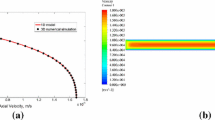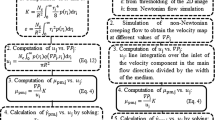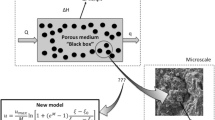Abstract
This work addresses the explanation for the threshold pressure sometimes observed in porous media flow leading to so-called non-Darcian flow where a certain external pressure is required to initiate macroscopic flow. Using the Langevin equation, it is first shown that the rapid fluctuating random pressure spikes on each side of the grains in porous media caused by molecular collisions between fluid molecules and the mineral surfaces generate a root mean square (RMS) pressure value even in the absence of macroscopic flow. The RMS pressure can be interpreted as a zero-rate resistance pressure term, which will act as a threshold resistance pressure over which the externally supplied pressure must exceed to initiate macroscopic flow. Using the fluctuation dissipation theorem, the RMS threshold pressure value is quantified, and its magnitude is mainly governed by the specific surface area of the medium and the thermal kinetic energy of the fluid molecules, i.e., the system temperature. Measurable threshold pressures are therefore expected to occur in media with high specific surface areas which is in line with empirical observations. Plotting Darcy velocity vs. pressure gradient for different threshold gradients shows good agreement with measured data. The presence of the zero-rate pressure resistance term further supports the existence of a thermal resistance term previously introduced under dynamic flow conditions. In the latter case, the re-active viscous resistance term must also be included to obtain the total flow resistance. A generalized form of Darcy’s law is therefore proposed, which accounts for the small pressure fluctuations observed in the absence of macroscopic flow, and therefore contains two resistance terms under dynamic conditions, i.e., viscous- and thermal resistances. Another implication of the nature and presence two resistance terms is also discussed with respect to flow resistance during aqueous vs. gaseous flow, essentially the Klinkenberg effect. This work connects porous media flow description, more specifically the mechanism underlying the thermal resistance mode, to well-known phenomena which require considerations about the molecular nature of fluids, e.g., the fluid-particle phenomenon called Brownian motion. It is shown that the fluid-porous medium system in the static case essentially is Brownian motion in the limit of large size porous media. The effect of the molecular collisions is, however, averaged out in this case and therefore insufficient to generate “Brownian motion” but can instead be measured and used to characterize the system. Such an interpretation is supported experimentally by the ever-present small pressure fluctuations of thermal origin, which show red or Brownian noise behavior.





Similar content being viewed by others
Data Availability
All data on request.
Code Availability
None.
References
Avraam, D.G., Payatakes, A.C.: Flow regimes and relative permeabilities during steady-state two-phase flow in porous media. J. Fluid Mech. 293, 207–236 (1995). https://doi.org/10.1017/S0022112095001698
Bear, J.: Dynamics of Fluids in Porous Media. Dover publications Inc., Mineola (1972)
Bolt, G.H., Groenevelt, P.H.: Coupling phenomena as a possible cause of “non-Darcian” behaviour of water in soil. Bull. Int. Assoc. Sci. Hydrol. 14(2), 6 (1969)
Brown, R.: A brief account of microscopical observations made in the months of June, July and August 1827, on the particles contained in the pollen of plants; and on the general existence of active molecules in organic and inorganic bodies. Phil. Mag. 4, 161–173 (1828)
Callen, H.B., Welton, T.A.: Irreversibility and generalized noise. Phys. Rev. 83(1), 34 (1951)
Chapman, S., Cowling, T.G.: The Mathematical Theory of Non-uniform Gases. Cambridge University Press, Cambridge (1953)
Darcy, H.: Les Fontaines Publiques de la Ville de Dijon. Dalmont, Paris (1856)
Einstein, A.: Über die von der molekularkinetischen Theorie der Wärme geforderte Bewegung von in ruhenden Flüssigkeiten suspendierten Teilchen. Ann. Phys. 17, 549 (1905)
Gillespie, D.T.: Markov Processes: An Introduction for Physical Scientists. Academic Press Inc., Cambridge (1992)
Grassia, P.: Dissipation, fluctuations, and conservation laws. Am. J. Phys. 69(2), 113 (2001)
Hassanizadeh, S.M., Gray, W.G.: High velocity flow in porous media. Transp. Porous Media 2, 521–531 (1987)
Hauge. E.H.: Forelsninger i teoretisk fysikk II B, NTH Trondheim Norway (1970)
Johnson, J.B.: Thermal agitation of electricity in conductors. Phys. Rev. 32, 97 (1928)
Khalatnikov, I.M.: An Introduction to the Theory of Superfluidity. CRC Press, Boca Raton (2000)
Kittel, C., Kroemer, H.: Thermal Physics. Freeman W.H. and Co., New York (1980)
Kjelstrup, S., Bedeaux, D., Hansen, A., Hafskjold, B., Galteland, O.: Non-isothermal transport of multi-phase fluids in porous media. Constitutive equations. Front. Phys. 6, 150 (2019). https://doi.org/10.3389/fphy.2018.00150
Klinkenberg, L.J.: The permeability of porous media to liquids and gases, Drilling and Production Practice, API 200–213 (1941)
Kubo, R.: The fluctuation-dissipation theorem. Rep. Prog. Phys. 29, 255 (1966)
Kutilek, M.: Non-Darcian flow of water in soils (Laminar region), 1st IAHR Symp. Fundamental of Transport Phenomena in Porous Media, Haifa, Israel (1969)
McClure, J.E., Berg, S., Armstrong, R.T.: Thermodynamics of fluctuations based on time-and-space averages. Phys. Rev. E 104, 035106 (2021)
Menke, H.P., Gao, Y., Linden, S., Andrew, M.G.: Using nano-XRM and high-contrast imaging to inform micro-porosity permeability during Stokes-Brinkman single and two-phase flow simulations on micro-CT images. Front. Water (2022). https://doi.org/10.3389/frwa.2022.935035
Moebius, F., Or, D.: Interfacial jumps and pressure bursts during fluid displacement in interacting irregular capillaries. J. Colloid Interface Sci. 377(1), 406 (2012)
Moebius, F., Canone, D., Or, D.: Characteristics of acoustic emissions induced by fluid front displacement in porous media. Water Resour. Res. 48, W11507 (2012)
Moura, M., Måløy, K.J., Grude Flekkøy, E., Toussaint, R.: Intermittent dynamics of slow drainage experiments in porous media: characterization under different boundary conditions. Front. Phys. 7, 217 (2020). https://doi.org/10.3389/fphy.2019.00217
Måløy, K.J., Moura, M., Hansen, A., Grude Flekkøy, E., Toussaint, R.: Burst dynamics, upscaling and dissipation of slow drainage in porous media. Front. Phys. 9, 796019 (2021). https://doi.org/10.3389/fphy.2021.796019
Nyquist, H.: Thermal agitation of electric charge in conductors. Phys. Rev. 32, 110 (1928)
Ross, G.J.: Relationships of specific surface area and clay content to shrink-swell potential of soils having different clay mineralogical compositions. Can. J. Soil Sci. 58, 159–166 (1978)
Rücker, M., Georgiadis, G., Armstrong, R.T., Ott, H., Brussee, N., van der Linde, H., Simon, L., Enzmann, F., Kersten, M., Berg, S.: The origin of non-thermal fluctuations in multiphase flow in porous media. Front. Water (2021). https://doi.org/10.3389/frwa.2021.671399
Rücker, M., Berg, S., Armstrong, R.T., Georgiadis, A., Ott, H., Simon, L., Enzmann, F., Kersten, M., de With, S.: The fate of oil clusters during fractional flow: trajectories in the saturation-capillary number space. In: International Symposium of the Society of Core Analysts held in St. John’s, Canada (2015)
Ruth, D., Ma, H.: On the derivation of the Forchheimer equation by means of the averaging theorem. Transp. Porous Media 7, 255–264 (1992)
Sen, P.N., Straley, C., Kenyon, W.E., Whittingham, M.S.: Surface-to-volume ratio, charge density, nuclear magnetic relaxation, and permeability in clay-bearing sandstones. Geophysics 55, 61–69 (1990)
Siddiqui, F., Soliman, M.Y., House, W., Ibragimov, A.: Pre-Darcy flow revisited under experimental investigation. J. Anal. Sci. Technol. 7, 2 (2016). https://doi.org/10.1186/s40543-015-0081-2
Smith, R.J.: Circuits, Devices, and Systems, 4th edn. Wiley, Hoboken (1984)
Spurin, C., Rücker, M., Moura, M., Bultreys, T., Garfi, G., Berg, S., Blunt, M.J., Krevor, S.: Red noise in steady-state multiphase flow. Water Resour. Res. 58(7), e2022WR031947 (2022)
Standnes, D.C.: A phenomenological description of the transient single-phase pore velocity period using the resistance force-velocity relationship. Adv. Geo-Energy Res. 6(2), 104–110 (2022a)
Standnes, D.C.: Derivation of the conventional and a generalized form of Darcy’s law from the Langevin equation. Transp. Porous Media 141, 1–15 (2022b)
Standnes, D.C.: Dissipation mechanisms for fluids and objects in relative motion described by the Navier–Stokes equation. ACS Omega 6(29), 18598 (2021). https://doi.org/10.1021/acsomega.1c01033
Standnes, D.C.: Implications of molecular thermal fluctuations on fluid flow in porous media and its relevance to absolute permeability. Energy Fuels 32, 8024 (2018)
Standnes, D.C., Sleveland, D.S., Kristoffersen, A.: Thermally induced pressure fluctuations in single-phase fluid-saturated porous media described by the fluctuation dissipation theorem. Transp. Porous Media (2022). https://doi.org/10.1007/s11242-022-01865-6
Swartzendruber, D.: Soil water behavior as described by transport co-efficients and functions. Adv. Agron. 18, 327–370 (1966)
Swartzendruber, D.: Non-Darcian movement of soil water. In: Internat Soil Water Symposium Prague, 207–222 (1967)
The Engineering ToolBox: https://www.engineeringtoolbox.com/air-absolute-kinematic-viscosity-d_601.html
Uhlenbeck, G.E., Ornstein, L.S.: On the theory of the Brownian motion. Phys. Rev. 36, 823–841 (1930)
Winkler, M., Gjennestad, M.A., Bedeaux, D., Kjelstrup, S., Cabriolu, R., Hansen, A.: Onsager-symmetry obeyed5 in athermal mesoscopic systems: two-phase flow in porous media. Front. Phys. 8, 60 (2020). https://doi.org/10.3389/fphy.2020.00060
Whitaker, S.: The Forchheimer equation: a theoretical development. Transp. Porous Media 25, 27–61 (1996)
Zwanzig, R.: Time-correlation functions and transport coefficients in statistical mechanics. Annu. Rev. Phys. Chem. 16, 67–102 (1965)
Acknowledgements
Equinor ASA is acknowledged for permission to publish the paper and Dagfinn S. Sleveland at University of Stavanger Norway for performing the pressure measurement reported in Fig. 3.
Funding
None.
Author information
Authors and Affiliations
Contributions
DCS: Conceptualization and writing the paper. AK: Writing and review.
Corresponding author
Ethics declarations
Conflict of interest
No conflicts of interest/competing interests.
Additional information
Publisher's Note
Springer Nature remains neutral with regard to jurisdictional claims in published maps and institutional affiliations.
Appendix
Appendix
The average of the fluctuating random pressure squared is according to the FDT generated as the product of the resistance in the absence of macroscopic flow and the average energy of a harmonic oscillator integrated over all angular frequencies \(\omega\) for the fluctuating fluid molecules (Callen and Welton 1951),
where \(E\left(\omega ,T\right)=\frac{1}{2}\mathrm{\hslash }\omega +\frac{\mathrm{\hslash }\omega }{{e}^{\frac{\mathrm{\hslash }\omega }{{k}_{B}T}-1}}\) is the average energy of the oscillator and \(\hslash\) is Planck’s constant divided by \(2\uppi\). The term takes the equipartition value, \({k}_{B}T\), at high temperatures so \(E\left(\omega ,T\right) \sim {k}_{B}T\) at ambient conditions upon neglecting the zero-point energy term, \(\frac{1}{2}\mathrm{\hslash }\omega\). Equation (17) can then be integrated directly if the flow resistance \({R}_{F}\) is constant. Using the substitution, \(d\omega =2\pi df,\) therefore gives,
where \(\Delta f\) is the bandwidth of the molecular oscillations. The flow resistance, \({R}_{F}\), is defined by writing Darcy’s law on the same form as Ohm’s law for electrical resistances (Standnes et al. 2022). Hence, it is given as the proportional coefficient in the equation,
where \(q\) is the measurable volume flow rate. \({R}_{F}\) must, however, be generalized compared to the conventional Darcy’s law as previously mentioned (Eq. (3)) because of the presence of the thermal resistance mode. Using the expression for the permeability in Eq. (3) with a weight factor \(W=0\) since no macroscopic flow is assumed together with the thermal efficiency factor expression, \(\Delta {P}_{T}=\frac{4}{3\pi }\frac{{K}^{*}}{\upphi }\left[\frac{{\mathrm{SV}}_{B}}{2\widehat{\mathrm{A}}}\right]\frac{\rho (1+\varepsilon )}{L}\sqrt{\frac{8{k}_{B}}{m}}\) (Standnes 2021), gives,
where \({R}_{T}\) is the resistance in the absence of viscous resistance because \(W=0\) under static conditions. Inserting Eq. (20) into Eq. (18) hence gives for the average fluctuating pressure squared according to the FDT,
The threshold value expression is then given as, \({\Delta p}_{\mathrm{THR}}=\sqrt{\langle \Delta {p}_{R}^{2}\rangle }\), which can be compared to the instantaneous measured fluctuations converted to an RMS value given by Eq. (14).
Rights and permissions
Springer Nature or its licensor (e.g. a society or other partner) holds exclusive rights to this article under a publishing agreement with the author(s) or other rightsholder(s); author self-archiving of the accepted manuscript version of this article is solely governed by the terms of such publishing agreement and applicable law.
About this article
Cite this article
Standnes, D.C., Kristoffersen, A. Threshold Pressure in Non-Darcian Flow Derived from the Langevin Equation and Fluctuation Dissipation Theorem: Generalized Darcy’s Law. Transp Porous Med 148, 479–497 (2023). https://doi.org/10.1007/s11242-023-01951-3
Received:
Accepted:
Published:
Issue Date:
DOI: https://doi.org/10.1007/s11242-023-01951-3




